Looking for the best things to do and see in Boston? Here’s my guide to the must visit landmarks and attractions in Boston, for your bucket list.
Boston is a dream destination, especially for history buffs and culture vultures. The city boasts an incredible array of art and architecture.
The country’s oldest city, Boston is steeped in American history. Boston played a pivotal role in the Revolutionary War.
Boston’s sometimes called the “hub of the world” or the “cradle of liberty” because it was the source and inspiration for key ideas that shaped America.
Boston is easy to get around and compact, making it perfect for travelers. The subway will take you wherever you need to go. And Boston’s very walkable.
35 Landmarks To Visit In Boston
Let’s tour Boston, taking in all its must visit attractions and some hidden gems. There’s so many amazing things to do in Boston that you could be busy for a month.
But here are the 35 landmarks and destinations to put on your Boston itinerary:
1. Acorn Street: Prettiest Street in the United States
Acorn Street is America’s most photographed street. Just south of Louisburg Square, Acorn Street is often called the most beautiful street in America. The narrow short lane just screams “Beacon Hill.” You’ll might feel like you’re in an 18th century romance novel.
Do the obligatory selfie amid its cobblestones and townhouses. Be sure to wear comfortable shoes to brave the cobblestones and uneven sidewalks.
2. Ayer Mansion: Tiffany Decorations
Ayer Mansion is a registered historic landmark in the back Bay. The 1902 mansion is a rare surviving home created and decorated entirely by Louis Comfort Tiffany.
His trademark stained glass windows shine above the front door. Inside, you’ll find beautiful glass mosaics, intricate woodwork, and a jaw dropping chandelier. The piece de resistance, though, is the mosaic staircase in the entrance hall.
Tours of the Ayer Mansion are offered at least one Saturday and one Wednesday per month. Though the museum is house is closed to the public for maintenance during August, a tour schedule is regularly available on ayermansion.org.
Address: 95 Commonwealth Avenue
3. Back Bay: Brick & Brownstones
Boston’s Back Bay is New England’s version of New York’s SoHo and West Village. You’ll want to stroll down Beacon, Marlborough, Commonwealth, Newbury, and Boylston streets.
Back Bay is a beautiful space to meander aimlessly, with pretty brownstones and tree-lined streets. There are plenty of old Victorian mansions and churches in this neighborhood that date back to the 19th century. If you want to tour a brownstone, pop into Gibson House Museum at 137 Beacon Street.
Back Bay’s churches are adorned with heavenly stained glass, perhaps the neighborhood’s greatest architectural asset. The most notable glass is in Arlington Street Church. It boasts 16 stunning stained glass windows created by Louis Comfort Tiffany.
More Tiffany stained glass decorates the Church of the Covenant on Newbury Street. This church also houses the Gallery NAGA, featuring New England artists.
You may want to book a guided walking tour of the Back Bay.
4. Back Bay Fens: Roses Galore
Boston’s Back Bay Fens are located in the Fenway neighborhood. It’s a beautiful green space in Boston filled with formal and community gardens and some historic landmarks and war memorials.
The fens were founded in 1879 by Frederick Law Olmsted. At the time, the fens were a stagnate waterway. Olmsted transformed the marsh into a beautiful urban landscape.
The most beautiful part of the fens is the Kelleher Rose Garden. It was planted in 1941. It’s a community garden spanning 7.5 acres. So beautiful is the garden, that it’s a popular spot for weddings.
Address: 100 Park Avenue
5. Beacon Hill: Bostons’ Oldest Neighborhood
Beacon Hill is an extremely pretty and exclusive neighborhood of gaslit streets and brick sidewalks. The homes, many designed by the ubiquitous Bulfinch, were built for Boston’s Protestant merchant elite, known as the Boston Brahmins.
Start your tour of Beacon Hill at Louisberg Square. The smart bow front homes date from the 1830s.
Drop down nearby Willow Street and take in the cobblestoned Acorn Street, America’s most photographed street. For the grandest homes, head back up Mount Vernon Street. The home of famed Boston architect Charles Bulfinch is on Chestnut Street.
End your walk on Beacon Street. The bow front William Hickling Prescott home (#55) is a Bulfinch masterpiece open to the public.
6. Boston Athenaeum: A Library Built By Brahmins
At the foot of Beacon Hill lies Boston’s oldest library and one of its oldest museums, the Boston Athenaeum. When you pass through its red leather doors, you’ll discover one of Boston’s most beloved hidden gems.
An athenaeum is a studious sanctuary, named after the Greek goddess Athena, devoted to research and learning.
A designated National Historic Landmark, the Boston Athenaeum is one of the oldest and most esteemed private membership libraries in the United States. And it’s the most beautiful library-haven you’ve never heard of, with Colonial decor and Louis Comfort Tiffany painted ceilings.
Opened in 1849, the Boston Athenaeum is in the heart of the city, adjacent to Boston Common. Past library members include luminaries and patriots such as John Quincy Adams, Ralph Waldo Emerson, Amy Lowell, Henry Wadsworth Longfellow, and Daniel Webster.
Today, the collection boasts over a half million volumes, beautiful paintings, sculptures, rare books, and manuscripts. There’s a special emphasis on the history of Boston and New England, English and American literature, and fine and decorative arts. If you’re a culture vulture or bookworm, the Athenaeum is a must see site in Boston.
Address: 10 1/2 Beacon Street
7. Boston Common: Boston’s Oldest Green Space
Boston Common is the oldest city park in the United States, dating back to 1634. In Boston’s early days, the park was used for cattle grazing and as a training field for the British militia.
Much like the green in the Tower of London, the Common was center stage in American history. It was used for hangings, duels, and spirited oratory.
Today, the Common’s historic green lawn is used as a playground. The Common hosts public celebrations, concerts, Shakespeare plays, and holiday festivals. Speakers like Barack Obama and Martin Luther King Jr. have used the Common to rally New Englanders.
Boston Common is also the first stop on the Freedom Trail, a historic 2.5 mile marked walking trail. For the full scoop, you may want to book a guided walking tour.
8. Boston Museum of Fine Art: World Class Collections
The Boston Museum of Fine Arts is a world class museum. It can be daunting to visit because it’s so massive.
Established in 1870, it’s the fourth largest museum in the United States. Founded in 1876 and housed in a Beaux Art building, the museum was later expanded by architect I.M. Pei.
The collection has everything from Egyptian mummies to minimalist Mondrians. The museum’s collection of Impressionist and Post-Impressionist work is among the world’s finest, second in the United States only to Philadelphia’s Barnes Foundation.
Some of the must see masterpieces in the museum include Van Gogh’s Postman Joseph Roulin, Monet’s Poppy Field in a Hollow Near Giverny, Goya’s Seated Giant, and Rembrandt’s Portrait of a 62 Year Old Woman,
READ: Guide To Monet’s House and Gardens in Giverny
If viewing fatigue sets in, head to the peaceful Shapiro Rotunda on Level 2 with classical murals by John Singer Sargent.
Address: 465 Huntington Avenue
9. Boston Public Garden: Make Way For Ducklings and Swans
Boston Public Garden is a lush oasis of 24 acres located right next to Boston Common. The park is the prettiest place of natural beauty in Boston. It’s famous for its bronze Make Way or Ducklings statue, a landmark designed by Boston native Nancy Schon.
In the spring, the garden is a spectacular sea of tulips. In the summer months, you can take a swan boat ride on the lagoon. In the fall, you’ll find fiery autumn foliage.
The garden also has some magnificent statues. Near the Arlington Street entrance, there’s a statue of George Washington that’s considered one of the best equestrian statues in the United States.
Address: 4 Charles Street
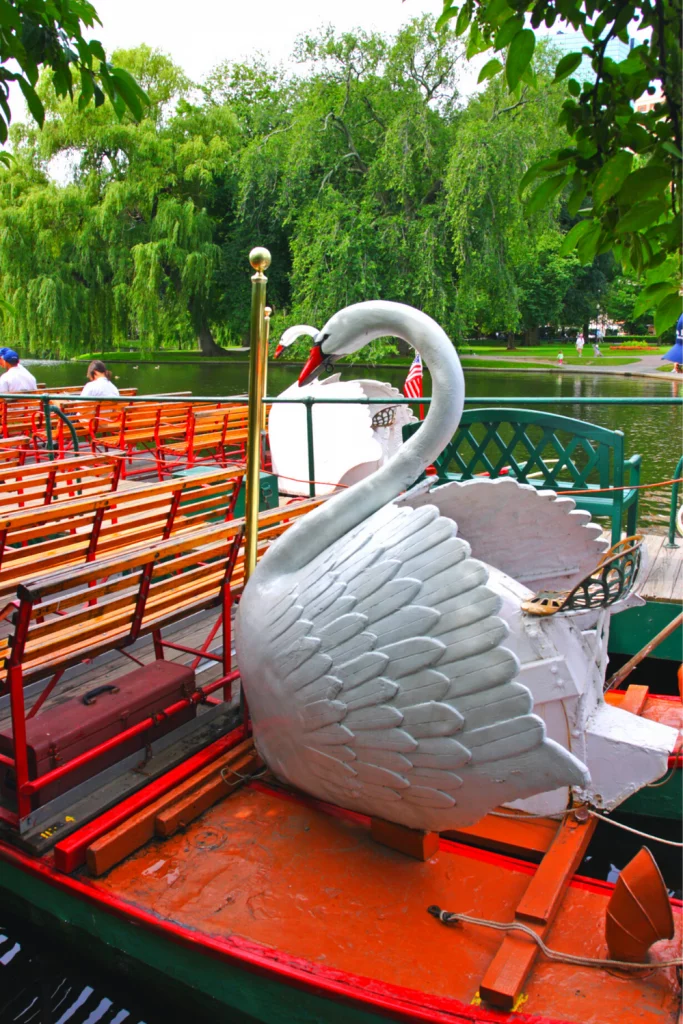
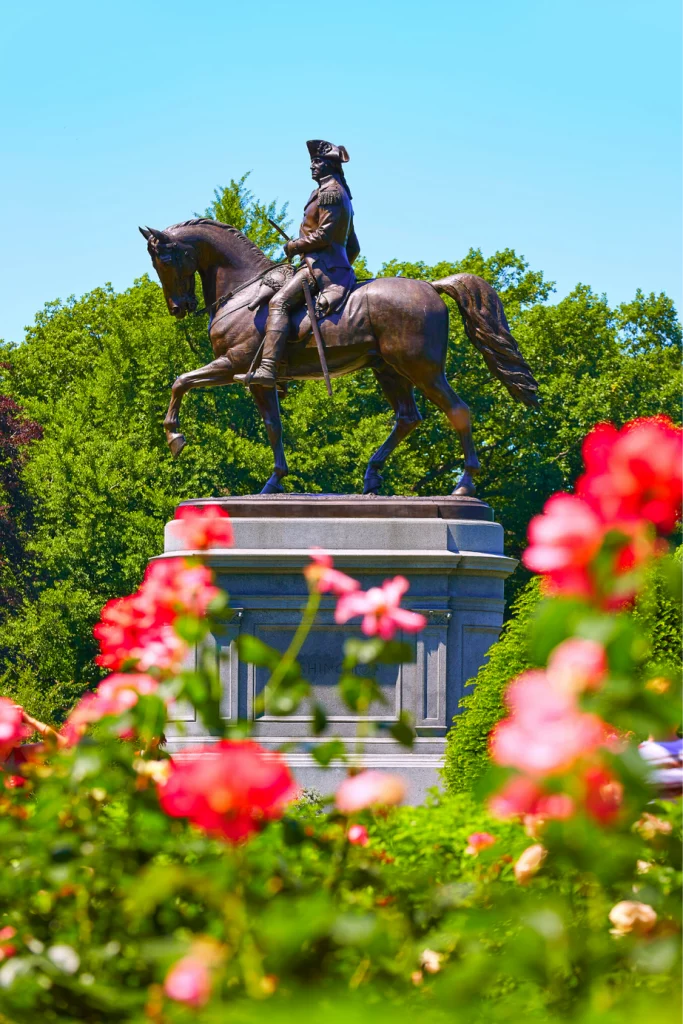
10. Boston Public Library: Elegant Reading Room
Boston Public Library is the third largest library in the country. Opened in 1848, it’s one of the largest municipal libraries in the country — home to 24 million items and welcoming almost 4 million visitors annually. The library was the first free public library in the United States and first to lend books.
The historic library is designed in a palatial Renaissance Revival style. It’s housed in two buildings.
The historic McKin building was designed by architect Charles Follen McKim. It boasts art work by Daniel Chester French and John Singer Sargent. The highlight is the Bates Hall Reading Room (shown above). The modern Johnson building was designed by Philip Johnson.
The library is famous for its murals. The most beautiful one is upstairs in the dimly lit Sargent Hall. You can take a free art and architecture tour of the library from its Dartmouth Street entrance.
The library also has a stunning arcaded courtyard. The architecture was based on the Cancellaria Palace in Rome. It’s a quiet oasis that’s an antidote to the business of Copley Square.
Address: 700 Boylston Street
11. Boston Symphony Hall: For Music Lovers
The Boston Symphony Orchestra is one of the five major orchestras in the United States. They’re referred to as the “Big Five.”
The symphony orchestra performs in Boston’s stately concert hall in the Back Bay during the fall, winter, and spring seasons. Built in 1900, the hall is considered one of the best concert halls in the world. There are statue-filled niches along the three sides, with replicas of Greco-Roman statues related to the arts.
In the summer, the company moves to Tanglewood, a beautiful destination in the Berkshires.
Address: 301 Massachusetts Avenue
12. Bunker Hill Monument
The Bunker Hill Monument is a massive granite obelisk marking the spot of the bloody Battle of Bunker Hill. Taking place on June 17, 1775, it was the first pitched battle of the American Revolution.
Although the British won the battle, the provincial soldiers killed or wounded 1,000 British soldiers. According to lore, patriots shouted “Don’t shoot until you see the whites of their eyes!”
You can climb 294 steps up the gigantic granite obelisk for decent views over the city. Across the street from the monument grounds, is the Bunker Hill Museum, housing exhibits about the famous battle.
Address: Monument Square, Boston National Historical Park
13. Faneuil Hall Marketplace: Get Your Lobster Roll
Built in 1742, Faneuil Hall is an iconic Boston landmark. It was a gift from the wealthy merchant and slave trader Peter Faneuil. It served as an open air market and Boston’s first town meeting hall.
Faneuil Hall was a political hotbed, where patriots protested British authority and taxation. Here, Samuel Adams and James Otis gave impassioned speeches. Citizens rallied against the British taxation statutes. Faneuil Hall earned the nickname the “Cradle of Liberty.”
In 1806, America’s first professional architect Charles Bulfinch enlarged the building. After the revolution, citizens gathered for anti-slavery speeches. Advocates of women rights also gave speeches there.
As a result, Faneuil Hall is the most visited destination in New England. It has an open ground floor serving as a market, a covered assembly room above (the Great Hall), and a grasshopper weathervane atop the roof. In the Revolutionary era, town meetings and ceremonies were once held in the assembly room.
Address: 4 South Market Street
14. Fenway Park: America’s Oldest Baseball Field
Boston’s Fenway neighborhood is known for its iconic ballpark, Fenway Park. Opened in 1912, it’s the oldest baseball stadium in the United States. History is alive in Fenway Park.
The stadium is prized for its eccentricities. Like many classic ballparks, Fenway was built on a asymmetrical block, causing unusual field dimensions.
A corner is center field is 420 feet away from home plate, the longest one in baseball. In contrast, the “Green Monster” is only 310 feet from home plate and is a popular target for right-handed hitters.
The most famous legend associated with Fenway is the Curse of the Bambino. Babe Ruth played with the Red Sox at the beginning of his career from 1914-19.
When he was traded to the Yankees in 1919, the Red Sox had won three world series in four years. Without Ruth, the Red Sox fortunes crashed and Ruth went on to become the great hitters in baseball history.
Address: 24 Beacon Street
15. Freedom Trail: Footsteps of History
The Freedom Trail is a beloved 2.5 mile walk through historic Boston. It leads you through the major sites and monuments relating to the city’s founding and the Revolutionary War. You follow a red brick road, with signs and historic markers along the way.
The trail begins in the Boston Common and ends at Bunker Hill. You can pick up a map and free guide at Faneuil Hall or the Boston Common Visitor Center at the beginning of the trail at 139 Tremont Street. Some stops are free and some charge admission.
Along the way, you’ll visit 16 historic Boston locations and landmarks, many of which are on this list of must see landmarks in Boston.
16. Harvard Art Museums: World Class Art
The Harvard Art Museums are a conglomerate of three separate museums — the Fogg Museum, the Biusch-Reisinger Museum, and the Arthur M. Sackler Museum.
After renovations by Renzo Piano from 2008-14, the museums were recently combined under a single glorious glass roof and renamed the Harvard Art Museums.
The Harvard Museums contain a range of collections from antiquity to the present day. The 250,000 exhibits are spread out over 7 levels. There’s also a theater and cafe.
The Fogg Museum houses a very good collection of Western art and Italian Renaissance paintings, including works by Botticelli, Ghirlandaio, and Bernini.
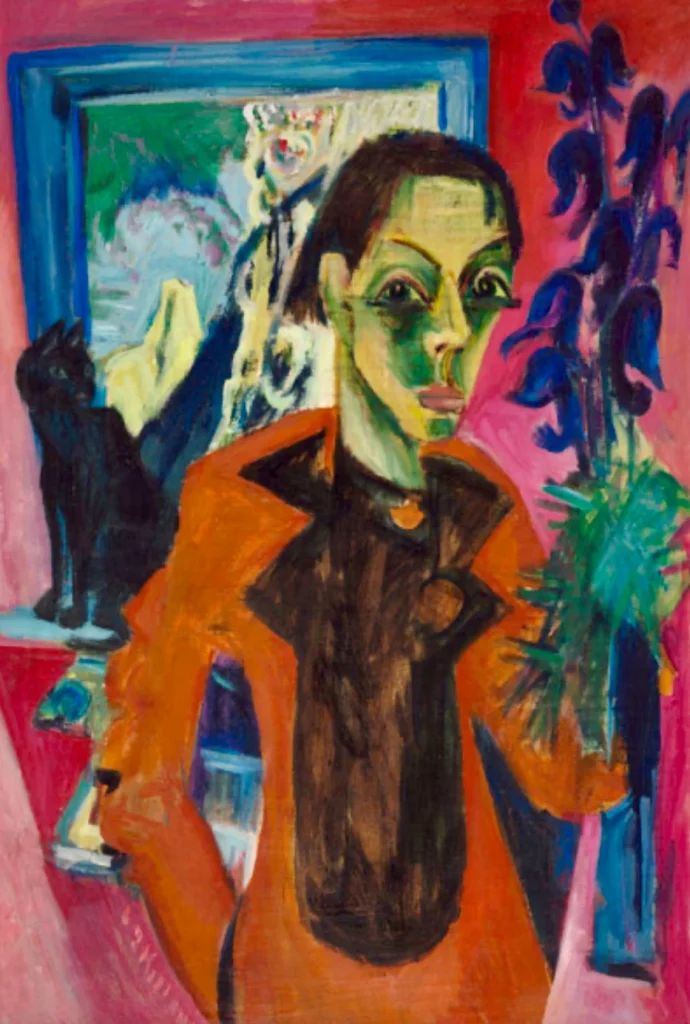
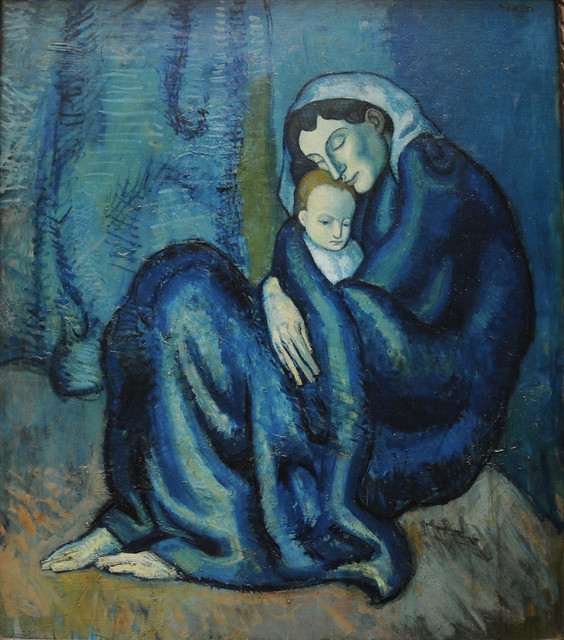
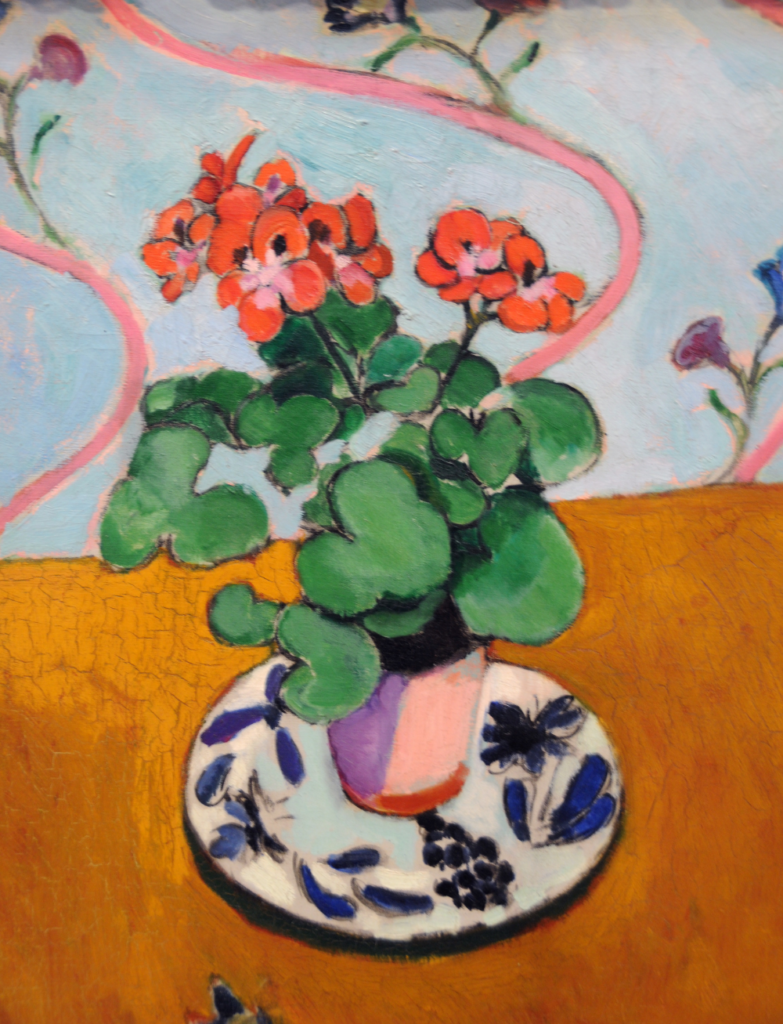
You’ll also find paintings by a roster of French Impressionist luminaries in the Maurice Wertheim Collection — Van Gogh, Picasso, Gauguin, Toulouse-Lautrec, and Manet.
Founded in 1901, the Busch-Reisinger Museum is dedicated to the art of Central and Northern Europe. The works cover the Austrian Secession, German Expressionism, and the Bauhaus design school. The Bauhaus works resulted from a partnership with Bauhaus founder Walter Gropius, a former chair of Harvard’s Department of Architecture.
The Arthur M. Sackler Museum is the newest of the trio, opening in 1985. It’s dedicated to Asian, Indian, Islamic, and Byzantine art. Highlights include beautiful Greek vases, carved jade from India, and a limestone Buddha.
READ: Guide To the World’s Best Small Museums
Address: 32 Quincy Street
17. Harvard Square: Buzzing Enclave
Harvard Square is the iconic center of Cambridge. It’s a triangular plaza located at the intersection of Battle Street, John F. Kennedy Street, and Massachusetts Avenue. You’ll find all manner of humanity — students, tourists, political activists, buskers, chess players, and other street creatures.
Wander around and experience the mix of life and small businesses. Stroll into used book stores, coffee shops, and chocolate shops. Watch artists, vagabonds, locals, and college students mingle. There are some cool little shops in the mini-mall called the The Garage.
There are plenty of eclectic boutiques in Harvard Square too. If you want to grab some Ivy league merchandise, head into the Harvard Coop. If you’re interested in unique clothing, try Boutique Fabulous, Susanna, or Mint Julep.
Harvard Square becomes very lively at night. Students gather to watch street performers. You can catch an independent movie at Brattle Theatre, take in a show at the American Repertory Theater, or enjoy a stand up show at Comedy Studio.
Address: Brattle Street Cambridge
18. Harvard Yard: Beautiful Harvard Architecture
As Harvard Square is the center of Cambridge, Harvard Yard is the nucleus of Harvard University. Founded in 1636, Harvard is the oldest university in America. You can take a free 70 minute walking tour with a student guide or just do a DIY stroll.
Start at the Johnston Gate on Massachusetts Avenue. You’ll be greeted by a statue of John Harvard, Harvard’s founder, carved by Daniel Chester French (of Lincoln Memorial fame) in 1884.
Ranged around the John Harvard statue are tree lined footpaths, trim lawns, scholarly libraries, and elegant Georgian and Federal architecture.
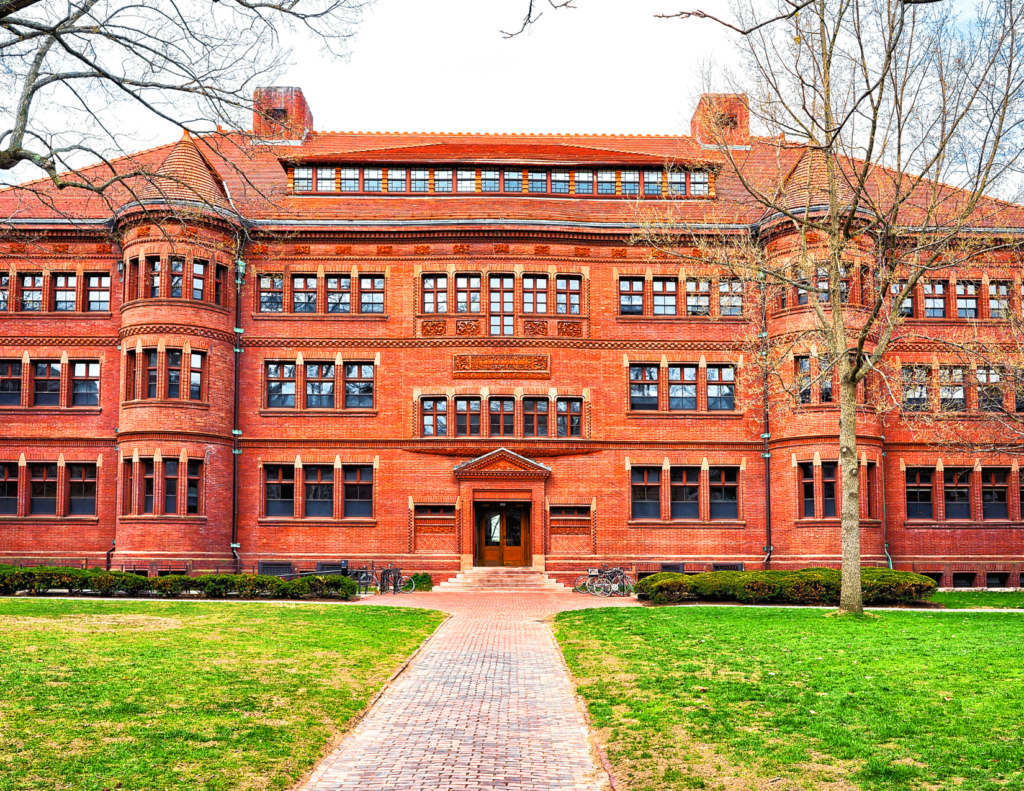
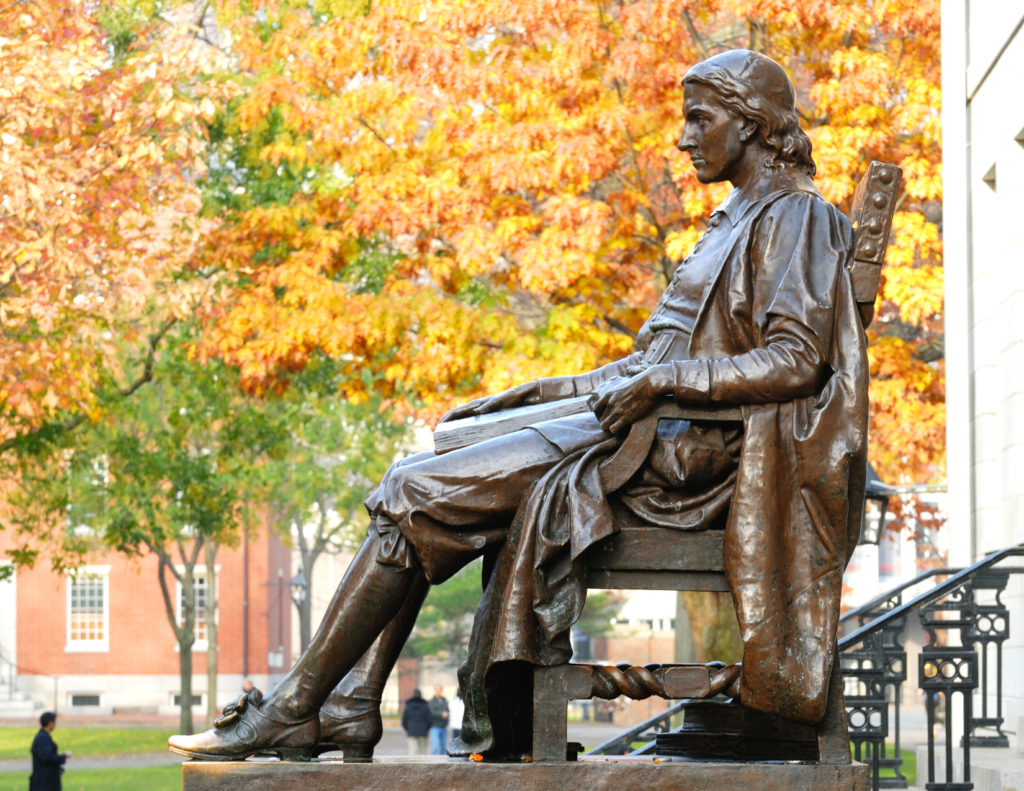
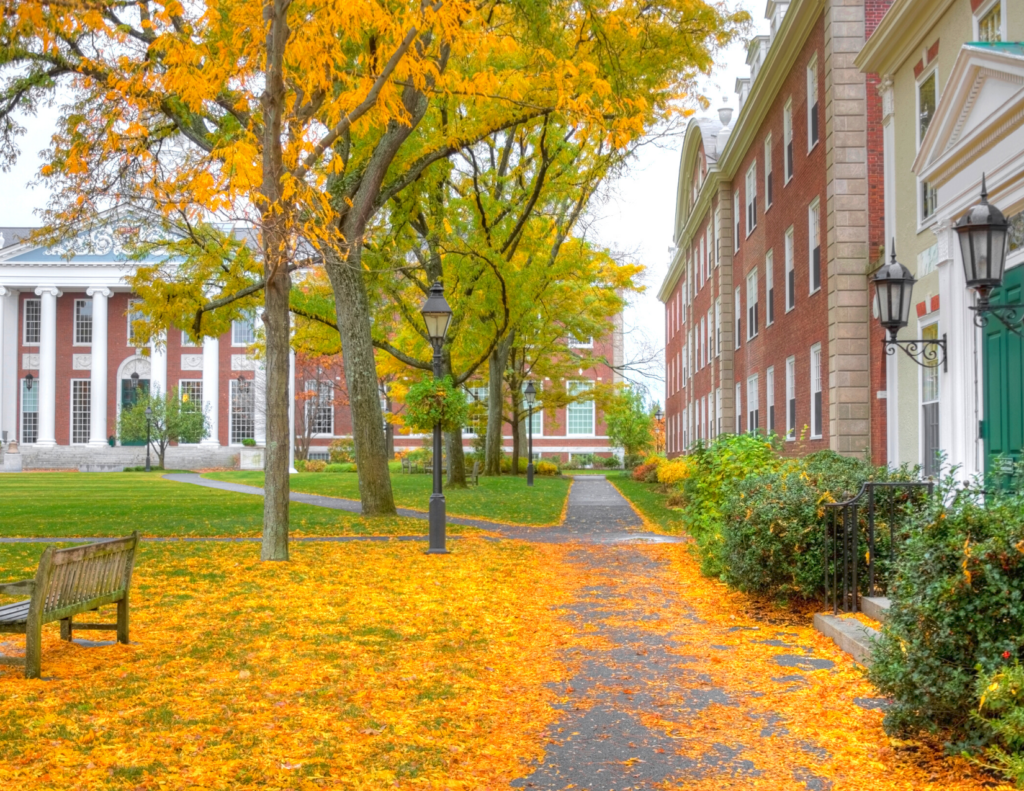
Massachusetts Hall is a Georgian gem, and the oldest surviving building at Harvard. But the building pales in comparison to the massive Gothic style Matthews Hall. Built in 1872, Matthews Hall is situated in the heart of Harvard Yard. It serves as a freshman dorm.
Behind the John Harvard statue is the graceful University Hall, dating from 1815. This granite building was designed by Bulfinch. It was the first building to veer away from Harvard’s trademark red bricks.
The New Yard is dominated by the colonnaded facade of Harvard’s flagship Widener Library. The library is an imposing building, whose entrance is graced with 12 Roman pillars and stands atop a 27 step granite staircase.
To see it all, you can book a walking tour with a Harvard alumni.
Address: 2 Kirkland Street
19. Isabella Stewart Gardner Museum: Paintings in a Palace
Housed in a Venetian-style palace, the exquisite Gardner Museum holds the in situ private collection of an eccentric heiress and premiere American collector.
The museum has a real wow factor, with a skylit interior courtyard filled with sculptures and mosaics. It’s one of the most unique museums in the United States.
The sky-lit interior courtyard has Roman, Venetian, and medieval architectural elements and sculpture. It can be seen from every level of the museum.
Inside, the museum has three floors of gallery spaces. It boasts works from the Italian Renaissance and Dutch Golden Age. The works by artistic luminaries such as Rembrandt, Raphael, John Singer Sargent, Titian, Piero della Francesca, and Veronese.
On the first floor, highlights include the Spanish Cloister with its enormous Moorish framed piece by John Singer Sargent, the Blue Room, and the Yellow Room.
On the second floor, there is the Dutch Room, the Raphael Room, the Early Italian Room, and the Tapestry Room. On the third floor, there is the Gothic Room, the Veronese Room, and the Titian Room.
Here’s my complete guide to the Gardner Museum.
Address: 25 Evans Way
20. King’s Chapel & King’s Chapel Burying Ground
King James II seized the land for this granite church in 1686. He established the first Anglican church in New England. In 1749, the Georgian style chapel was constructed around the original church.
The interior is considered one of the best examples of Georgian architecture in all of the united States. The church houses the oldest pulpit still in use and a Paul Revere designed church bell from 1816.
Next to the chapel on Tremont Street lies the King’s Chapel Burying Ground, used by the Loyalists.
You’ll find the graves of John Winthrop, Massachusetts first governor, and Mary Chilton, believed to be the first women to step off the Mayflower. The grave of Elizabeth Pain has a headstone said to inspire Hawthorne’s character Hester Prynne in The Scarlet Letter.
Address: 58 Tremont Street
21. Longfellow House: Poet’s House
Longfellow House is a Boston landmark located on Brattle Street, the historic road connecting old Cambridge and Watertown. It’s famous as the one time home of Henry Wadsworth Longfellow, who wrote stirring tales that thrilled 19th century America, including the Midnight Ride of Paul Revere.
In the Revolutionary War period, Brattle Street was nicknamed “Tory Row.” It was here that wealthy Loyalists built their residential mansions. The famous Longfellow House is open to the public in the summer months and its lovely garden is open year round.
Built in 1759, the Longfellow mansion was originally commsioned by John Vassall. He abandoned the mansion and fled to England when anti-Tory sentiment rose after the outbreak of the Revolutionary War. The mansion was then requisitioned by General George Washington, who used it as his headquarters during the Siege of Boston in 1775-76.
After the war, the mansion was bought by Andrew Craigie. It was later purchased for Henry Wadsworth Longfellow as a wedding gift.
Longfellow lived there for 35 years, hosting literary salon for the “Fireside Poets.” The mansion is preserved for posterity in the style of the Fireside Poets and is now a National Historic Landmark.
Address: 105 Brattle Street
22. Massachusetts Institute of Technology: Modern Architecture
MIT was founded in 1861 in response to increasing industrialization in the United States. It’s a groundbreaking center for theoretical and practical research in physical sciences and engineering. Once dissed as “the factory,” MIT is one of the finest universities in the world.
In contrast to the comparatively straight laced red brick architecture of Harvard, MIT is a fantasyland of quirky modern architecture and public sculpture. Start at the Neo-Classical Rogers Building at 77 Massachusetts Avenue. This is the entrance to the “Infinite Corridor.”
The corridor is the “spine” of MIT, a seemingly endless pedestrian hallway traversing the entire campus from east to west. It connects to each of the major buildings of MIT.
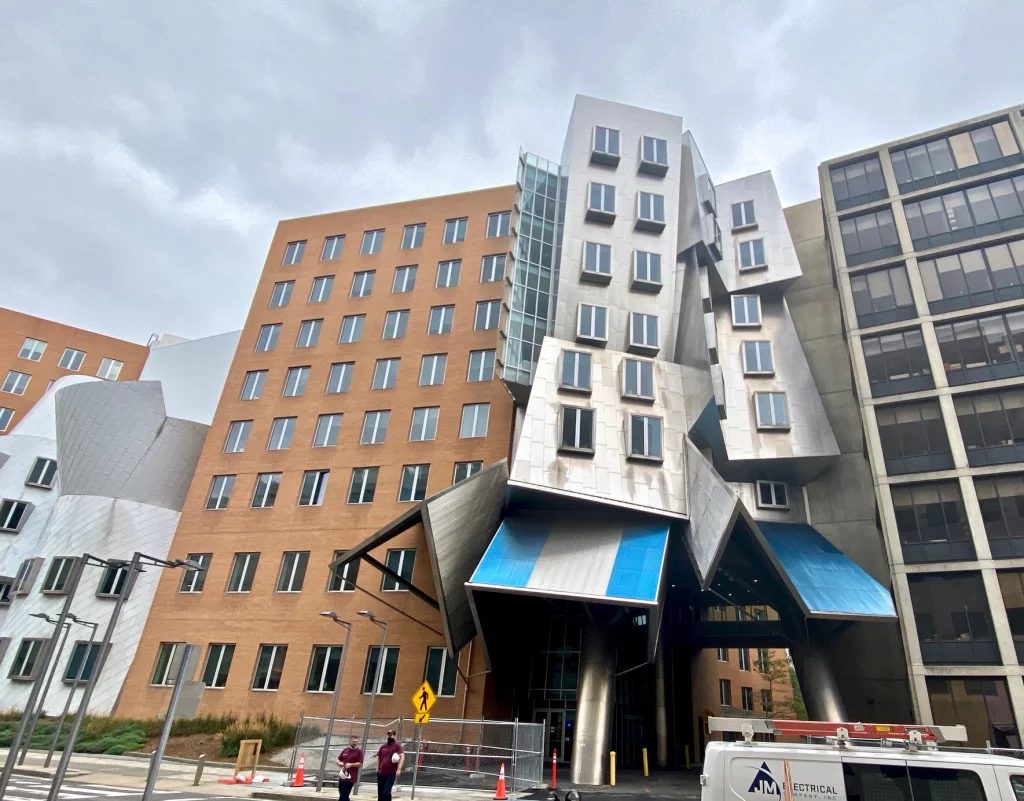
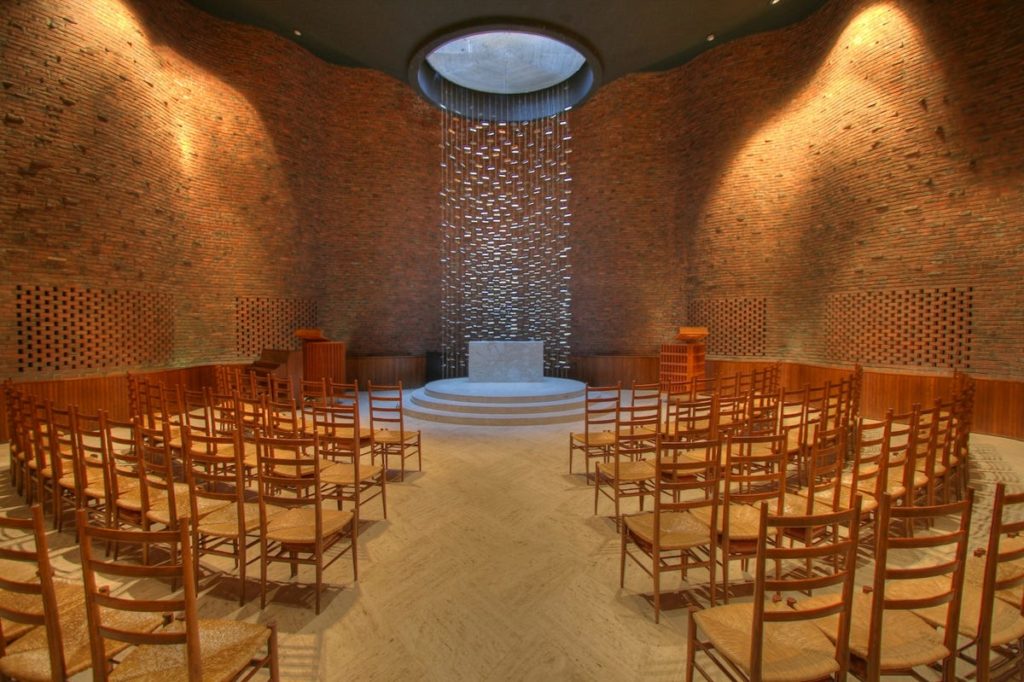
On the other side of Massachusetts Avenue you’ll find the circular MIT Chapel. Designed by Finnish architect Eero Saarinen, it consists of a moated red brick cylinder, topped with a sculptured belfry. The interior is windowless, illuminated by a roof oculus and floor level slits reflecting light upwards.
Don’t forget to check out the high rise Green Center on McDermott Court. This is one of several MIT buildings designed by I.M. Pei of Louvre Museum fame.
The architect Frank Gehry also left a definitive foot print at MIT. Gehry was a pioneer of the controversial post-modern style known as Deconstructivism.
His Stata Center on Vassar Street is classic Gehry, with silver elements exploding outward and colliding with each other. Even the windows appear to bulge.
To see it all, you can book an MIT walking tour.
Address: 77 Massachusetts Avenue
23. Massachusetts State House: Symbol of Freedom
This magnificent hybrid Neo-Classical and Federal style Stat House is Boston’s most famous landmark. The building reflects the ebullient nature of a newly freed republic.
Like much of Beacon Hill, it was designed by Charles Bulfinch. The state house was completed in 1798, and is the oldest building on Beacon Hill.
On July 4, 1795, Samuel Adams and Paul Revere laid the cornerstone on land that once served as John Hancock’s cow pasture. The red brick building’s first dome was wooden. In 1802, patriot Paul Revere covered it with copper to prevent water leakage. In 1874, the dome was gilded in 24 carat gold.
The Massachusetts State House is open to the public. You can take a guided or DIY tour weekdays from 10:00 am to 3:30 pm. Guided tours are approximately 30-45 minutes. You’ll learn about the history and architecture of the building and see the House and Senate chambers.
The Nurses Hall has murals of important Civil War episodes. Memorial Hall or the Hall of Flags is where regimental colors were returned after Civil War conflicts. The third floor houses the House of Representatives and a newly refurbished library.
The newest addition to the State House is the Great Hall, which was completed in 1990. Topped by a glass dome, this was previously an open air courtyard and is used for special ceremonies. A clock hangs in the center of the room.
Be sure to admire two statues on the state house grounds. One is Cyrus Dallin’s statue of Anne Hutchinson, who was driven out of Boston in 1638 for not conforming to Puritanism. The other is a statue of John F. Kennedy that was a gift from the people of Massachusetts.
Address: 24 Beacon Street
24. Newbury Street: Luxe Shopping Amid Historic Brownstones
Historic Newbury Street is a famed tree-lined street in Boston’s tony Back Bay neighborhood. Newbury Street is eight blocks long, located between Boston Public Garden and Massachusetts Avenue. It’s lined with historic 19th century brownstones.
Newbury Street is Boston’s most popular and chic shopping destination with high end boutiques, spas, art galleries, and elegant hotels and restaurants. You can window shop or indulge in high end fashion labels.
25. Old Granary Burying Ground: Patriot Resting Place
Right behind the Boston Athenaeum, you’ll find Granary Burying Ground. It’s the most visited cemetery in Boston. Old Granary is the third oldest burial ground in Boston, dating back to 1660.
The cemetery is the famous resting place of many freedom-loving patriots, including Paul Revere, John Hancock, and Samuel Adams. The victims of the Boston Massacre are also buried here, in the Adams’ family tomb.
The first and largest monument that you’ll see is the Benjamin Franklin Monument. No, the great man isn’t buried there. But his family is. The monument to the wealthy John Hancock, who helped fund the revolution, is easy to spot as well. The quirkiest grave is that of Mary Goose, purportedly of nursery rhyme fame.
Most people visit Old Granary to pay their respects to Paul Revere. His grave is directly behind the Franklin Monument, in the shape of a pedestal. Paul Revere, of course, was made famous by the Henry Wadsworth Longfellow poem The Midnight Ride of Paul Revere.
It’s free to enter the graveyard, which is open every day from 9:00 to 5:00 pm.
Address: Tremont Street
26. Old North Church
Old North Church is one of Boston’s most famous landmarks. It’s the subject of American folklore. The church was the official launching pad for Revere’s famous Midnight Ride.
Revere arranged to have lanterns perched on the steeple warning that the Redcoats were coming. Sexton Robert Newman hung the lanterns. Revere’s Midnight Ride is regarded as the event that sparked the American Revolution.
The Midnight Ride has been embellished, thanks to English poet Henry Wadsworth Longfellow’s poem entitled Paul Revere’s Ride. Revere did not single handedly warn the Boston countryside of the coming British invasion, as the poem implies. Nor did he shout “The British Are Coming.”
Aside from the glorious folklore, the church is a creaky wooden wonder inside. Among other things, you’ll find the only sculpture of George Washington in his best likeliness. If you go up the stairs to the steeple’s bell ringing chamber, on the way you’ll find a pair of lanterns thought to be identical to those hung in 1775.
Address: 193 Salem Street
27. Old South Meeting House
Built in 1729, Old South Meeting House is a must visit landmark and the second oldest church in Boston. It’s a symbol of the colonial mixture of church and state, one of the nation’s most important historic sites. The church sports a massive bronze bell made by Paul Revere in 1801.
Old South Meeting House was used as a meeting place for angry patriots. They held public meetings there when their numbers outgrew Faneuil Hall.
Many crucial events leading to the revolution occurred here, including events triggering the Boston Tea Party. In 1773, 5,000 people gathered to hotly debate and protest the British tea tax.
In 1872, the church was slated for demolition. It survived the wrecking ball only with the intervention of wealthy Bostonians who recognized the historic significance of the site. Since 1876, it’s been a museum. Inside, you’ll find historical exhibits and memorabilia, including an exhibit about freedom of speech.
Address: 310 Washington Street
28. Old State House
Built in 1713, the Old State House is one of Boston’s oldest landmarks. It was the seat of the royally-appointed colonial government. It was a center of political and commercial life, even housing a merchant’s exchange.
The Old State House played a central role in the revolution. It was the site of James Otis’ 5 hour speech against the Writs of Assistance (general search warrants) as an instrument of arbitrary power. In 1770, the Boston Massacre occurred in front of the building.
Today, the Old State House is a museum. Every 30 minutes, a colonial speaker in costume appears providing the audience with details of his or her life in colonial Boston.
Address: 206 Washington Street
29. Otis House Museum: Boston’s Wealthiest Colonial
This grand mansion was also designed by the ubiquitous Bulfinch. The Otis House straddles Beacon Hill and the West End, in a spot formerly known as Bowdoin Square. It was the first of three homes built for Boston politician and eventual mayor Harrison Gary Otis in 1796. Otis was the richest man in Boston.
Outside, the Otis House is all Federal style. It’s one of Boston’s earliest three story brick homes. It has a symmetrical facade with five bays and a fine Palladian window on the first floor with a lunette above.
Inside, the Otis House has been restored to its 1800 appearance. Its paint colors and carpets are rather loud yet historically accurate.
Bostonians had more flamboyant taste than the more muted Virginia colonials. There are pairs of rooms on either side of the central hall, which was the entertaining space.
In 1960, the Otis House was carefully renovated. Today, it sits, rather incongruously, against a backdrop of modern office buildings.
Address: 141 Cambridge Street
30. Park Street Church
Founded in 1809, Park Street Church was originally nicknamed “Brimstone Corner” because of the fiery sermons delivered onsite.
It was also where gun powder was stashed, in the crypt. Its 217 foot white steeple was once the first thing travelers saw when approaching Boston.
Only July 4, 1829, William Lloyd Garrison called for the abolition of slavery from the pulpit. Two years later, the hymn My Country Tis of Thee was sung on the church steps. The Boston chapter of the NAACP had its first meeting at this historic church.
Address: 1 Park Street
31. Paul Revere House
The Paul Revere House is the surviving house of the esteemed patriot. Built around 1680, it’s the oldest building in downtown Boston, with 90% of the original structure remaining. His rather tiny house was the starting point of Revere’s famous Midnight Ride.
Revere was not only a patriot, but also a fabulously successful silversmith, copper manufacturer, part time dentist, and engraver. He was the father of 16 children, 10 of whom survived childhood.
You can tour the house for $5. Though it seems small, the Revere House was considered a “mansion” at the time (according to the tour guide).
One mark of Revere’s wealth was the stained glass windows, indicating that he could afford to pay for heating. You’ll see a state of the art colonial kitchen and bedrooms decorated in period furniture.
Address: 19 North Square
32. Prescott House: a Beacon Street Historic Landmark
Beacon Street is lined with beautiful urban mansions facing Boston Common. The bow front William Pickering Prescott House (#55), designed by Asher Benjamin, is one of the best. History wasn’t just made here. It was written and filmed here (starring in the film Wish Man.)
Prescott House was built in 1808 for American’s first great historian, known for his Spanish War treatises. In 1944, the National Society of Colonial Dames of America purchased the mansion. 20 years later, it became a designed National Historic Landmark.
The museum offers tours. You can inspect the mix of Federal, Victorian, and Colonial Revival styles. There’s a faithfully restored library and study. The study has Prescott’s noctograph on display, one of the first devices to help the visually impaired write. The Prescott House also has a large costume collection of 18th century garments.
Address: 55 Beacon Street
33. South End
South End is a hipper version of Back Bay, and gets high marks for all things trendy. It stretches southwest along Tremont and Washington Streets to Roxbury.
South End’s glorious concentration of undulating Victorian row housing is unmatched anywhere in the US. In 1983, the entire area was listed on the National Register of Historic Places.
The area resembles Beacon Hill, probably because the street plan was laid out by the same architect, the very busy Charles Bulfinch. There are many beautiful squares. The prettiest and grandest one is Chester Square. Much of the Victorian cast iron is botanical in form.
34. Trinity Church
Boston’s Trinity Church is located in Copley Square. Founded in 1733, it’s Boston’s oldest and most beautiful church. The striking church was built in the 1870s after the original building burned down in the Great Fire of 1872.
The style is known as Richardsonian Romanesque, which embraces the use of clay roofing and rough hewn stonework. It was designed by Henry Hobson Richardson. Upon its completion, the church’s distinctive style influenced architects across the country because it was so beautiful. Its facade has twin square towers and a porch with three arched portals.
The interior is decorated with murals by John La Farge, covering over 20,000 feet. There’s a beautiful collection of stained glass windows with opalescent glass. The highlight is the Baptism Window in the chancel.
Address: 206 Clarendon Street
35. USS Constitution | Old Ironsides
Cross the Charlestown Bridge, and you’re in the beautiful village of Charlestown. It’s worth the hike. Down Constitutional Road, you’ll find the ship known as Old Ironsides in the Charlestown Navy Yard.
Launched in 1797, Old Ironsides is the oldest commissioned warship afloat in the world. The ship’s nicknamed derived from the fact that the British cannonballs appeared to bounce of her impenetrable hull.
The ship that survived British attacks is now a free museum. Tours are led by active duty sailors. You’ll go below deck and see what life on a ship was like in the 1800s. There’s a lot to absorb here, which may advocate for starting your Freedom Trail hike at Bunker Hill rather than Boston Commons.
Address: Building 22, Charlestown Navy Yard, Charlestown
I hope you’ve enjoyed my guide to the best must visit landmarks and attractions in Boston. You may enjoy these other New England travel guides:
- 3 Days in Boston Itinerary
- Must See Sites in Salem
- What To Do On a Berkshires Road Trip
- 10 Day Road Trip for New Hampshire
- 10 Day Road Trip for Coastal Maine
- Fall Foliage Road Trip in New England
- 1 Week Road Trip in Vermont
- 25 Prettiest Small Towns in New England
- 21 Hidden Gems on the East Coast
- Best Art Towns on the East Coast
If you’d like to visit Boston’s must visit landmarks, pin it for later.

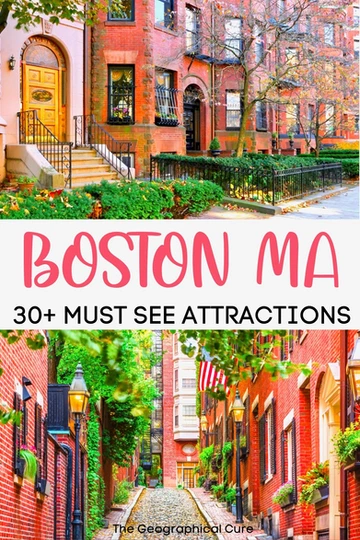
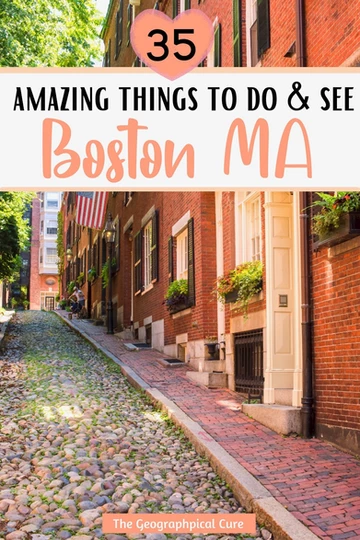
Well, First time I will read this Blog. This is useful info for me. I will take the Boston tour.